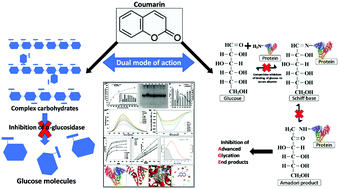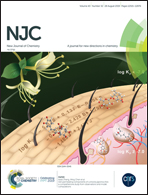Mechanism of non-enzymatic antiglycation action by coumarin: a biophysical study†
Abstract
Glycation is predominantly a non-enzymatic reaction of free amino groups of biological macromolecules like protein and DNA with reducing sugars or other metabolic intermediates. Its end products called advanced glycation end products (AGEs) whose rate of formation is enhanced under hyperglycaemia. Glycation induces structural and functional changes in proteins contributing to complications related to diabetes such as neuropathy, retinopathy and cardiovascular complications. In this study, the in vitro antiglycation action of coumarin was studied on both glucose and methylglyoxal induced glycation of human serum albumin (HSA). Inhibition of α-glucosidase activity by coumarin was also studied. The mechanism of inhibition of glycation by coumarin was evaluated by studying the interaction between coumarin and HSA using biophysical tools. There was ∼80% inhibition of fluorescent AGEs by coumarin. Fructosamine and carbonyl contents were substantially reduced in the presence of coumarin. Coumarin protected free lysine modification and glycation-induced aggregation of HSA. Interaction studies revealed that coumarin bound at sub-domain IIA of HSA and the complexation process was spontaneous and thermodynamically favourable. The energy transfer efficiency between HSA and coumarin was 15.62% and the donor–acceptor distance was 2.63 nm. The binding energy obtained was −6.4 kcal mol−1 and coumarin was surrounded by Arg257, Ala261, Leu238, Leu260, Ile290 and Ala291 of HSA. In the presence of coumarin, vmax and km were decreased suggesting a mixed type of inhibition of α-glucosidase. This study deciphers the antiglycation potential of coumarin and its possible mechanism of action. This may prove to be useful in the development of AGE inhibitors.



 Please wait while we load your content...
Please wait while we load your content...